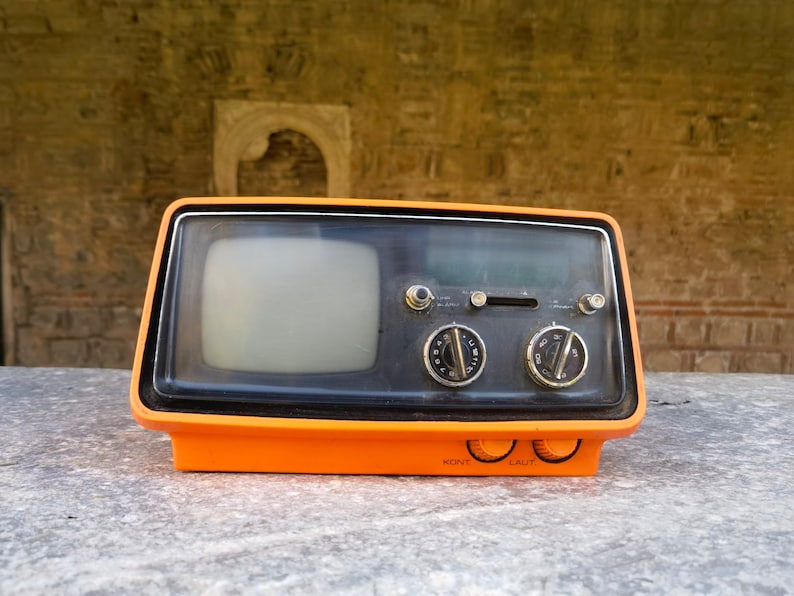For the final project, I am not completely set on what I want to do but have brainstormed some exciting potential ideas. The idea that is most appealing to me involves making a Spotify-connected jukebox in the 1960s/70s Space Age aesthetic. To achieve this aesthetic, I plan to purchase an old TV from the time period. I have already looked on Facebook Marketplace and eBay and most can be bought for around $25-50. The display of the TV would be hooked up to a Raspberry Pi or similar device that will be connected to WiFi and therefore able to access Spotify. A couple of years ago, I came across a DIY project on YouTube where someone repurposed an old iPod to run Spotify on it. This project uses a Raspberry Pi as well, so I believe that my idea would be feasible. Since I already have speakers in my bedroom that are connected to an Amazon Echo, I would be able to use Bluetooth or WiFi in order to play the music on them.
This “jukebox” would essentially be a music control and visualization device, rather than including its own speakers. I think that it would be a cool desktop piece where I could control my music without taking my phone out. Additionally, I am considering repurposing the physical buttons on the old TV to control functions such as playlist selection, play/pause, track skipping, and volume.
Diving more into the Space Age aesthetic, it focuses on clean lines, minimalist forms, streamlined shapes, metallic elements, and bold colors. As evident in the name, it takes a lot of inspiration from the design of rockets and spacecraft during the Space Race in the 1960s. I think that the juxtaposition of this old design language with the more modern digital Spotify aspect will work well together. Most of these TVs used CRT display technology, something that is obviously not as high resolution as current flatscreens but in a way full of more character. These displays have a lot of grain, fuzziness, and distortion. However, similar to how film cameras compare to digital cameras, these imperfections often add more personality to the medium. Below, see some examples of TV styles I may end up using:

Source: https://www.ebay.com/itm/155801414377
Source: https://www.ebay.com/itm/204430649442?chn=ps&mkevt=1&mkcid=28
Source: https://www.etsy.com/listing/1667471505/shiljalis-401-vintage-mini-television?gpla=1&gao=1&
As you can see, these TVs have the common design traits of the Space Age aesthetic. I think the tactility of the buttons and knobs would make the experience for navigating through the Spotify interface a pleasant experience. Another design feature I may try to pursue is fitting the Raspberry Pi and other necessary electronics into the body of the TV. This would make everything neater and overall a more clean design.
Looking forward, I think that this idea could be very promising. I do have experience using Raspberry Pi and DIY electronics, but I hope to learn more during the course of this project. The only issue that may come up is procuring the TV within a short time frame and for a low cost.


5 Comments. Leave new
I love that you are playing with technology from different time periods. It is interesting to take a new software (spotify) and put it on an old TV screen. It is especially cool because at one point the TV would have been considered an advanced technology!
Hey Arjun,
This is a really neat idea! I saw someone else make something sort of similar, but with an NFC reader on the Pi and NFC cards with album art to sort of replicate putting on records, but the entire thing interfaced with Spotify. To respond to Lavender’s comment, I wonder if there’s some way that you could find the source of the whine and then put it in some kind of sound-absorbing box to reduce the whine. I would think you would probably have some room left since you won’t need a lot of the electronics in the TV, but I could be wrong on that. Would you use the speakers on the TV itself, or were you thinking of using some other ones?
I was planning on using some existing bookshelf speakers that are currently connected to an Amazon Echo. Because of this, they can be connected via Bluetooth or WiFi through the Raspberry Pi.
I personally love this idea; I also have a soft spot for the space-age look, and this seems like a perfect way to reuse an old mini TV. Your ideas of fitting the assembly entirely inside and rewiring the old buttons and knobs to use as controls are excellent as well. As for the CRT screen, while I agree that their imperfect and warm-colored display helps the aesthetic, I worry about the whine that they all produce interfering with the music being played – would that bother you? Do you have any plans on mitigating this somehow?
I never considered the whine so I’ll have to see when I get my hands on the TV. As Josh mentioned, I could modify the component producing the whine or insulate the TV a bit to mitigate it.